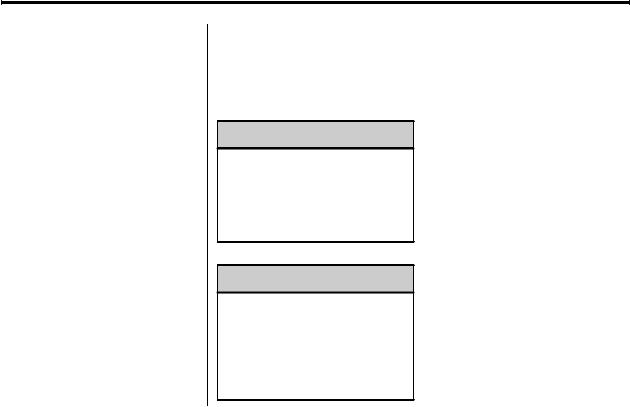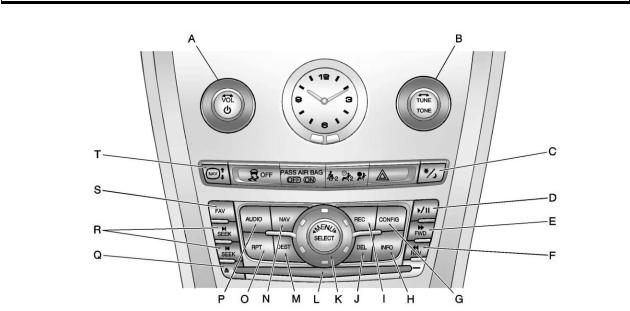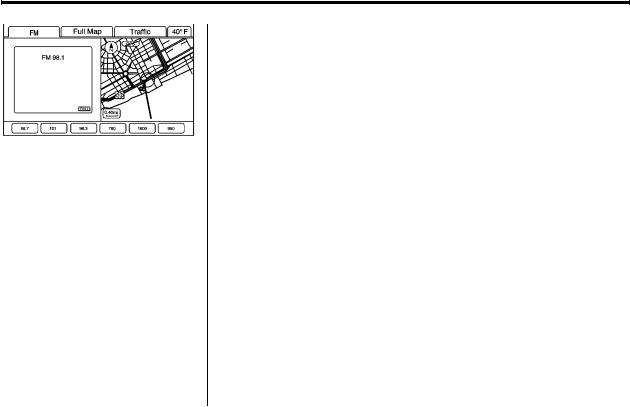Cadillac CTS Sedan 2011 Navigation Manual

2011 Cadillac CTS/CTS-V Navigation System M
Infotainment System . . . . . . 3
Introduction . . . . . . . . . . . . . . . . . . 3
Overview . . . . . . . . . . . . . . . . . . . . . . . 3
Radio . . . . . . . . . . . . . . . . . . . . . . . 11
AM-FM Radio . . . . . . . . . . . . . . . . . 11
Satellite Radio . . . . . . . . . . . . . . . . 16
Audio Players . . . . . . . . . . . . . . 17
CD/DVD Player . . . . . . . . . . . . . . . 17
MP3 . . . . . . . . . . . . . . . . . . . . . . . . . . 22
Hard Drive Device (HDD) . . . . . 27
Auxiliary Devices . . . . . . . . . . . . . . 32
Navigation . . . . . . . . . . . . . . . . . . 35
Using the Navigation
System . . . . . . . . . . . . . . . . . . . . . . 35
Maps . . . . . . . . . . . . . . . . . . . . . . . . . . 38
Navigation Symbols . . . . . . . . . . . 40
Destination . . . . . . . . . . . . . . . . . . . . 44
Configure Menu . . . . . . . . . . . . . . . 57
Global Positioning
System (GPS) . . . . . . . . . . . . . . . 65
Vehicle Positioning . . . . . . . . . . . . 65
Problems with Route
Guidance . . . . . . . . . . . . . . . . . . . . 66 If the System Needs
Service . . . . . . . . . . . . . . . . . . . . . . 67 Ordering Map DVDs . . . . . . . . . . 67 Database Coverage
Explanations . . . . . . . . . . . . . . . . . 67
Voice Recognition . . . . . . . . . . 68
Speech Recognition . . . . . . . . . . . 68
Trademarks and License
Agreements . . . . . . . . . . . . . . . 70
Index . . . . . . . . . . . . . . . . . . . . . i-1

Infotainment System 3
Introduction
GENERAL MOTORS, GM, the GM Emblem, CADILLAC, the CADILLAC Crest & Wreath, and the name CTS are registered trademarks of General Motors LLC.
The information in this manual supplements the owner manual.
This manual describes features that may or may not be on your specific vehicle either because they are options that you did not purchase or due to changes subsequent to the printing of this owner manual.
Litho in U.S.A.
Part No. 20814351 B Second Printing
Please refer to the purchase documentation relating to your specific vehicle to confirm each of the features found on your vehicle. For vehicles first sold in Canada, substitute the name “General Motors of Canada Limited” for Cadillac Motor Car Division wherever it appears in this manual.
Keep this manual with the owner manual in the vehicle, so it will be there if it is needed. If the vehicle is sold, leave this manual in the vehicle.
Canadian Vehicle Owners (Propriétaires des Véhicules Canadiens)
A French language copy of this manual can be obtained from your dealer or from:
On peut obtenir un exemplaire de ce guide en français auprès du concessionnaire ou à l'adresse suivante:
Helm, Incorporated
P.O. Box 07130
Detroit, MI 48207
1-800-551-4123
Numéro de poste 6438 de langue française
www.helminc.com
Overview
Read this manual thoroughly to become familiar with how the navigation system operates.
© 2010 General Motors LLC. All Rights Reserved.

4Infotainment System
Keeping your eyes on the road and your mind on the drive is important for safe driving. The navigation system has built-in features intended to help do this. Some features may be disabled while driving. Note that these functions are grayed-out. A grayed-out function indicates it is not available when the vehicle is moving.
All functions are available when the vehicle is parked. Do the following before driving:
.Become familiar with the navigation system operation, hard keys on the faceplate, and touch-sensitive screen buttons of the navigation system.
.Set up the audio by presetting favorite stations, setting the tone, and adjusting the speakers.
.Set up the navigation features before beginning driving, such as entering an address or a preset destination.
.Set up your phone numbers in advance so they can be called easily with the press of a single button or a single voice command (for navigation systems equipped with phone capability).
{ WARNING
Taking your eyes off the road too long or too often while using the navigation system could cause a crash resulting in injury or death to you or others. Focus your attention on driving.
{ WARNING
Avoid looking too long or too often at the moving map on the navigation screen. This could cause a crash and you or others can be injured or killed. Use the turn-by-turn voice guidance directions whenever possible.
Use the navigation system to:
.Plan a route.
.Select a destination using various methods and choices.
.Follow turn-by-turn route and map guidance with voice prompts, only if permitted by traffic laws, controls, and conditions.
.Receive RDS broadcast announcements.
Always be alert and obey traffic and roadway laws and instructions, regardless of the guidance from the navigation system. Because the navigation system uses street map information that does not include all traffic restrictions or the latest road changes, it may suggest using a road that is now closed for construction or a turn that is prohibited by signs at the intersection. Because the system uses limited information, always

Infotainment System 5
evaluate whether following the system's directions is safe and legal for the current conditions.
{ WARNING
Taking your eyes off the road for extended periods could cause a crash resulting in injury or death to you or others.
To help avoid a crash in which you or others could be killed:
.Always concentrate on your driving first by keeping your eyes and mind on the road, and your hands on the wheel.
.Follow system directions only if permitted by traffic laws, controls, and conditions.
.Before using this system, read the owner manual and learn how it operates.
.Some system controls cannot be used the when vehicle is moving.
When the navigation system is turned on, a screen may appear with the information below, and you must read and acknowledge the information it contains.
After acknowledging the start up information you will be able to access the NAV (navigation) and DEST (destination) functions. Once accessed, enter or delete information in the navigation system or access other functions. See instructions later in this section.
Each time the vehicle is started and the navigation system is turned on, the Caution screen may appear.
If the Caution screen appears, press OK to accept the Caution. If OK is not selected, all control buttons except for NAV and DEST can be accessed. Once NAV or DEST are pressed, this Caution screen appears and OK must be pressed to access the navigation map.
When getting started the navigation system can be set to preferences or information that has been entered can be deleted using various options.

6Infotainment System
CTS Shown, CTS-V Similar

Infotainment System 7
A.VOL/ O (Volume/Power Knob).
B.TUNE/TONE.
C.! (Dimming Change Button).
D.k (Play/Pause).
E.[ FWD (Forward).
F.r REV (Reverse).
G.CONFIG (Configure).
H.INFO (Information).
I.REC (Record).
J.DEL (Delete) Key.
K.q MENU r SELECT.
L.CD/DVD Slot.
M.DEST (Destination).
N.NAV (Navigation).
O.RPT (Repeat).
P.AUDIO key.
Q.Y (CD/DVD Eject).
R.u t SEEK.
S.FAV (Favorite).
T.NAV n m (Navigation Screen Up/Down).
Language
To change the language of the navigation screens, see “DIC Vehicle Customization” in the Index of the vehicle's owner manual.
English or Metric Units
To change the navigation screens from English or metric, see “DIC Operation and Displays” in the Index of the vehicle's owner manual.
Deleting Personal Information
This navigation system can record and store destinations and personal information such as names and addresses. When disposing of the vehicle, you may want to delete this information. See “Previous Destinations — Deleting” and “Address Book — Editing and Deleting Entries” under Destination on page 44 for deleting this information.
Storing Radio Station Presets
Up to 36 preset stations can be stored. AM, FM, and XM
(if equipped) can be mixed. To store presets:
1.Press O to turn the system on.
2.If viewing a map screen, press the source screen button, press AUDIO, or press FAV.
3.Select the band.
4.Seek or tune to the desired station, to select the station.
5.Press and hold one of the preset screen buttons for more than one and a half seconds.
6.Repeat the steps for each preset.
To change the number of preset pages, see “Number of Preset Pages” under AM-FM Radio on page 11 for more information.

8Infotainment System
Entering an Address and Point
of Interest, and Storing Preset
Destinations
The vehicle must be in P (Park) to perform these operations.
Entering an Address
If having trouble finding a city or a street name:
.Enter the street name first instead of the city name, or vice versa.
.Enter more characters or reduce the amount of characters to reduce or expand the available options.
To set a destination by entering a street name:
1.Press O to turn the system on.
2.A caution may appear. Press OK to proceed.
3.Press the DEST control button.
4.Select the Street screen button.
5.The Street name category is automatically selected for entry. Start entering the street name.
It is recommended that directional information or street type is not entered, and use the Space screen button between street or city names. Use the backspace ( q ) screen button if an incorrect character has been entered.
If four or less names are available for the entered characters, a list displays.
If more than four are available, there is a match counter with a number in it, it represents the number of available streets. Press the List screen button to view the list and select a street.
While the Street name category is empty, there is a Last 5 Streets screen button that displays the last five selected streets. Press this button to select a street from the list.
6.Enter the house number. The system displays the house number range that is available for the street.
7.If there is more than one city, the list of cities that have that street name and house number displays. Select a city from
the list.
8.A confirmation screen displays with the address. If the address is correct, press Go. The system calculates the route.
9.Select the route preference (Fastest, Shortest, or Easy). The system highlights the route.
10.Press the Start Guidance screen button. The route is now ready to be started.
See “Address Entry” under
Destination on page 44 for more information.

Infotainment System 9
Entering a Point of Interest (POI)
To set a destination by entering a Point of Interest (POI):
1.Press O to turn the system on.
2.A caution may appear. Press OK to proceed.
3.Press the DEST control button.
4.Press the Point of Interest screen button.
5.Enter the specific title of
the POI in the POI name space (e.g. Washington Monument).
If four or less names are available, a list displays. If more than four are available, there is a match counter with a number in it, it represents the number of available POI names. Press the List button to view the list. Select the POI.
6.Press the Go screen button. The system calculates the route.
7.Select the route preference (Fastest, Shortest, or Easy). The system highlights the route.
8.Press the Start Guidance screen button. The route is now ready to be started.
See “Point of Interest (POI)” under
Destination on page 44 for more information.
Storing Preset Destinations
1.Press O to turn the system on.
2.A caution may appear. Press OK to proceed.
3.Press the NAV or DEST control button.
4.Enter a destination. See
Destination on page 44 for information on how to enter a destination.
5.Press the Add screen button from the map screen to add the current final destination to the address book.
The address book screen appears.
6.Press the Name screen button. An alpha-keyboard displays. Enter the name.
7.Press and hold one of the screen buttons at the bottom of the screen until the text in the button changes.
The address book entry name appears in that preset destination screen button and is now available to select from the Select Destination screen. See “Using Your Stored Preset Destinations” next in this section to select it as a destination.
See “Adding or Changing Preset Destinations” under Destination on page 44 for more information on how to add preset destinations.

10 Infotainment System
Using Your Stored Preset
Destinations
These destinations are available for selection while driving.
1.Press O to turn the system on.
2.A caution may appear. Press OK to proceed.
3.Press the DEST control button.
4.Select one of the available preset destination screen buttons. The system calculates the route.
5.Select the route preference (Fastest, Shortest, or Easy). The system highlights the route.
6.Press the Start Guidance screen button. The route is now ready to be started.
See “Preset Destination” under
Destination on page 44 for more information.
Canceling Guidance
Guidance is canceled once you arrive at the final destination. To cancel guidance prior to arrival at the final destination:
1.Press DEST.
2.Press the Cancel Guidance screen button.
3.Press the Yes screen button to confirm cancellation.
Voice Guidance
To adjust the volume of voice guidance prompts:
1.Press the CONFIG control button to enter the menu options, then press CONFIG until Nav is selected or press the Nav screen button.
2.Press the Voice Volume screen button.
3.Press the + or – screen buttons to increase or to decrease the volume of the voice prompts.
See “Voice Volume ” under Speech Recognition on page 68 for more information.
Cleaning the Display
If the panel or the display is stained, wipe it with a dry, soft cloth, such as a silicon cloth.
Notice: Using abrasive cleaners when cleaning glass surfaces, could scratch the glass. When cleaning the glass, use only a soft cloth and do not spray cleaner directly on the system.
Do not apply spray cleaner directly to the system, the cleaner could affect the mechanical parts.
Do not wipe the panel with a hard cloth or use a volatile liquid such as thinner or alcohol, it could scratch the surface or erase the characters.

Infotainment System 11
Radio
AM-FM Radio
Playing the Radio
O (Power/Volume):
1.Press to turn the audio system on and off.
2.Turn to increase or decrease the volume.
TUNE/TONE:
1.Turn to go to the next or previous frequency.
2.Press to display the Sound menu. See “Sound Menu” later in this section.
AUDIO:
1.Press to display the full audio screen.
2.Press to switch between AM, FM, XM™ (if equipped), CD, DVD, HDD, and AUX (auxiliary input), or press the screen button. See Satellite Radio on page 16 (if equipped), CD/DVD Player on page 17, Hard Drive Device (HDD) on page 27, and Auxiliary Devices on page 32 for more information.
Finding a Station
If viewing a map screen, press the source screen (AM, FM, and XM (if equipped), etc.) button. The display splits between the audio screen and the map screen. All station-changing functions can be performed from this screen.
FM Source Shown, Other Sources
Similar

12 Infotainment System
FM Source Shown, Other Sources
Similar
Press the AUDIO control button to view a split screen while on a map screen.
AM/FM/XM (if equipped): Select the source (AM, FM, or XM™,
if equipped) or press the AUDIO control button repeatedly until the desired source is highlighted.
FM Source Shown, Other Sources
Similar
1.Press the button, located in the middle of the screen, to receive a list of all of the selected band stations in the area.
2.Use the up and down arrow buttons to scroll the frequencies.
3.Select the frequency.
FM lists may also contain a category to select if stations in the area support Radio Data Systems (RDS).
Refresh: Press to refresh the list of AM or FM stations.
Functions shown below only applies to XM (if equipped).
DEL (Delete): Press to remove the currently displayed category.
Restore CAT: Press to restore a category that was just removed
Restore All: Press to restore all categories that were removed.
In the audio split screen, the name of the station or channel displays.
u SEEK / t SEEK: Press the left or right arrow to go to the next or previous station and stay there.

Infotainment System 13
Storing Radio Station Presets
This feature allows storage of up to 36 preset stations. You can mix AM, FM, and XM™ (if equipped). To store presets:
1.Press O to turn the system on.
2.If viewing a map screen, press the source screen button, press the AUDIO or FAV control button.
3.Select the band.
4.Seek or tune to the desired station, to select the station.
5.Press and hold one of the preset screen buttons for more than one and a half seconds.
6.Repeat the steps for each preset.
To change the number of preset pages, see “Number of Preset Pages” later in this section.
Sound Menu
TONE or CONFIG (Configure):
Press the TONE or CONFIG control button to access the Sound menu to adjust the treble, midrange, bass, fade, balance, and Digital Signal Processing (DSP).
TREBLE: Press the + or − sign to increase or decrease the treble. If a station is weak or has static, decrease the treble.
MID (Midrange): Press the + or − sign to increase or decrease the midrange.
BASS: Press the + or − sign to increase or decrease the bass.
Adjusting the Speakers
L/R (Left/Right) (Balance): To adjust the balance between the left and the right speakers, press and hold the L or R screen buttons.
Front/Rear (Fade): To adjust the fade between the front and the rear speakers, press and hold the Front or Rear screen buttons.
Digital Signal Processing (DSP)
If the system has Digital Signal Processing (DSP), it is used to provide a choice of five different listening experiences. DSP can be used while listening to the audio system. The type of DSP selected is displayed on the status screen.

14 Infotainment System
DSP settings:
Normal: Adjusts the audio to normal mode. This provides the best sound quality for all seating positions.
Driver: Adjusts the audio to give the driver the best possible sound quality.
Rear: Adjusts the audio to give the rear seat occupants the best possible sound quality.
Centerpoint®: Turns on Bose Centerpoint®. Centerpoint® produces a full vehicle surround sound listening experience from a CD, MP3/WMA, DVD, AUX (auxiliary) input, or XM™
(if equipped) stereo digital audio source and delivers five independent audio channels
from the conventional two channel stereo recordings. This is not available for AM or FM.
5.1 Surround: 5.1 Surround sound processing is available for DVD-A/ DVD-V sources that were recorded in 5.1 surround.
.5.1 Surround + Normal: Best for all seating positions.
.5.1 Surround + Rear: Best for the rear seating position.
Radio Menu
Press the CONFIG control button to enter the menu screen, then press CONFIG repeatedly until Radio is selected or press the Radio screen button to make radio system changes.
Additional Information Displayed
Press Additional Information Displayed to turn station or channel information on or off.
Press On to receive information, when it is available, for the following; FM radio text information.
Press Off to receive no information.
Number of Preset Pages
Press the Number of Preset Pages screen button to change the number of preset pages, 1 through 6. Each preset page can contain six preset stations. Press the desired numbered screen button.

Infotainment System 15
Noise Compensation Technology: Bose® equipped vehicles include Bose AudioPilot® noise compensation technology.
When turned on, AudioPilot continuously adjusts the audio system equalization, to compensate for background noise, so that the music always sounds the same at the set volume level.
This feature is most effective at lower volume settings where background noise can affect how well the music is heard while being played through the vehicle's audio system. At higher volume settings, where the music is much louder than the background noise, there may be little or no adjustments by AudioPilot. For additional information on AudioPilot, visit www.bose.com/audiopilot.
To use AudioPilot:
1.Press the CONFIG control button to enter the menu screen, then press CONFIG repeatedly until Radio is selected or press the Radio screen button
2.Press the Automatic Volume Control screen button to access the AudioPilot menu.
3.Press the ON screen button.
To turn off, press the OFF screen button.
Timeshift
Timeshift records all information from AM, FM, XM™ (if equipped), etc. for up to an hour. Timeshift allows you to listen to information that was missed. Once starting to listen to one of the bands, timeshift automatically starts. Once timeshift has recorded for an hour, it will keep recording and start removing the information from the beginning.
Press k (pause) to stop hearing the information through the speakers. During this pause time, timeshift keeps recording.
Press k (play) to continue listening where you left off. During pause, a progress bar displays, to show how much time the system has been buffering.
Press k before turning the vehicle off so that Timeshift keeps recording for up to one hour. If the vehicle is still off after an hour of recording, the vehicle stops recording and all information is lost.
If stations are switched, during this hour period, timeshift erases all information that was recorded and starts recording from the current band. If you switch to listening to any other source, timeshift will not record.

16 Infotainment System
Radio Data System (RDS)
The audio system has a Radio Data System (RDS). RDS features are available for use only on FM stations that broadcast RDS information. With RDS, the
radio can:
.Seek to stations broadcasting the selected type of programming
.Receive announcements concerning local and national emergencies
.Display messages from radio stations
This system relies on receiving specific information from these stations and only works when the information is available. In rare cases, a radio station may broadcast incorrect information that causes the radio features to work improperly. If this happens, contact the radio station.
The RDS system is always on. When information is broadcast from the current FM station, the station name or call letters display on the audio screen. RDS may provide a program type (PTY) for current programming and the name of the program being broadcasted.
Satellite Radio
XM™ Category Restore
(If Equipped)
Press the “Yes” button of Restore All Categories screen to add all categories that have been removed. Press the “No” button of Restore All Categories screen to cancel.
XM™ Satellite Radio Service
(If Equipped)
XM™ is a satellite radio service that is based in the 48 contiguous United States and 10 Canadian provinces.
XM™ Satellite Radio has a wide variety of programming and commercial-free music, coast-to-coast, and in digital-quality sound. During your trial or when you subscribe, you will get unlimited access to XM™ Radio Online for when you are not in your vehicle.
A service fee is required to receive the XM service. For more information, contact XM™ at www.xmradio.com or call 1-800-929-2100 in the U.S. and www.xmradio.ca or call 1-877-438-9677 in Canada.
When XM™ is active, the channel name and number, category name, song title, and artist will display on the screen.
XM™ Radio Messages
See “XM™ Radio Messages” in the vehicle's owner manual for a list of possible XM messages.

Infotainment System 17
Audio Players
CD/DVD Player
Playing a CD
The player can be used for CD, MP3, and DVD audio and DVD video.
Things to know about playing a CD:
.With the ignition on, insert a CD or DVD partway into the slot, label side up. The player pulls it in and the CD or DVD should begin playing. While playing a CD or DVD, the navigation system is available. If you insert a CD or DVD with the system off and the ignition on, it starts
to play.
.When a CD or DVD is inserted, Gracenote logo display starts with the Gracenote database access and the CD/DVD tab activates.
.
.
.
.
.
The player is only compatible with CDs or DVDs of the appropriate region code that is printed on the jacket of most CDs and DVDs.
The CD/DVD slot is compatible with most audio CDs, CD-R, CD-RW, DVD-Video, DVD-Audio, DVD-R/RW, DVD +R/RW media along with
MP3 and WMA “un-protected” formats.
As each new track of a CD starts to play, the track number displays.
The player can only play the full-size (12 cm) discs.
If an error displays, see “CD/ DVD Messages” later in this section.
Playing an Audio CD
RANDOM:
1.Press to hear the tracks in random, rather than sequential, order.
2.Press again to turn off random play.

18 Infotainment System
r / j (Play/Pause):
1.Press to pause the CD, the pause symbol displays. This button will then change to the play button.
2.Press the play button to play the CD.
r(Rewind):
1.Press and hold to rewind quickly through a track selection.
A sound is heard at a reduced volume.
2.Release to stop rewinding. The display shows the elapsed time of the track.
[ (Forward):
1.Press and hold to fast forward quickly through a track selection. A sound is heard at a reduced volume.
2.Release to stop fast forwarding. The display shows the elapsed time of the track.
u SEEK / t SEEK:
1.Press the right arrow to go to the next track.
2.Press the left arrow to go to the start of the current track, if more than five seconds have played or to the previous track,
if five seconds or less have played.
3.If either arrow is pressed more than once, the player continues moving backward or forward through the CD. The sound mutes while seeking.
TUNE/TONE knob: Turn to go to the next or previous track.
Track List Screen: Press the center button on the main screen to go to the Track List Screen. Press the screen button to select a different song to play from the disc.
Playing a DVD
There are three ways to play a DVD:
.Once a DVD is inserted, the system automatically starts play of the DVD.
.Press AUDIO, then press the DVD screen button.
VOL/ O (Volume/Power):
1.Press to turn the system on and off.
2.Turn to increase or decrease the volume of the audio system.

Infotainment System 19
DVD Menu Options
Once a DVD starts to play, the menu options automatically appear. To display the menu choices while a DVD is playing in full screen, press anywhere on the screen.
There are two pages of menu options. Press the page number screen button, located in the bottom right corner of the screen, to use all of the menu screen buttons. Menu options are available when they are highlighted. Some menu options are only available when the DVD is not playing.
Full Screen:
1.Press this screen button to remove all menu options from the display.
2.Press anywhere on the screen to display the menu options.
Cursor: Press this button to access the cursor menu. The arrows and other cursor options allow navigation of the DVD menu options. The cursor menu options are only available if a DVD has
a menu.
q, Q , r , R (Arrow Buttons):
Use these arrow buttons to move around the DVD menu.
Enter: Press to select the highlighted option.
Return: Press to go back to the previous DVD menu.
Back: Press to go back to the main DVD display screen.
Move: Press to move the cursor buttons back and forth from the bottom-right corner to the top-left corner of the screen.
Random:
1.Press to hear the tracks in random, rather than sequential, order.
2.Press Random again to turn off random play. This button is not available for DVD video.

20 Infotainment System
c (Stop):
1.Press to stop play of the DVD.
2.Press k (play/pause) to continue playing the DVD from where the DVD was stopped.
3.Press twice to return to the beginning of the DVD.
k(Play/Pause):
1.Press to pause the DVD.
2.Press again to play the DVD from where the DVD was stopped.
Angle:
1.Press to adjust the viewing angle of the DVD.
2.Repeatedly press to toggle through the angles. This button is not available when the DVD is stopped. This may not be available on all DVDs.
Audio Stream:
1.Press to display the audio stream number and to change the language heard.
2.Repeatedly press to toggle through the available languages. This may not be available on all DVDs. This button is not available when the DVD is stopped.
Subtitle Stream:
1.Press to playback the video with subtitles.
2.Repeatedly press this button to toggle through the available languages.
3.To turn the subtitles off, press until Off is selected. This button is not available when the DVD is stopped. This may not be available on all DVDs.
Top Menu: Press to display the first menu of the DVD. This button is not available on all DVDs.
Menu: Press to display the DVD menu of the current area of the DVD that is playing. This button is not available for DVD audio.
Keypad: Press to display the title/ chapter, the group/track, or the menu number screen; type in the appropriate number on the keypad.

Infotainment System 21
Setup: Press to display the DVD Setup screen. The DVD Setup screen allows you to change the initial settings; language and aspect, to change the brightness, contrast, and mode, and to change autoplay. The initial settings and auto play are only available when the DVD is not playing.
Initial Settings: From the DVD Setup screen, press to change audio, subtitle, and menu languages, and to view the aspect of the DVD. The movie must be stopped to use this menu. These settings are not available on
all DVDs.
Audio Language: Press English, French, or Spanish to change the language that you are listening to.
Subtitle Language: Press English, French, or Spanish to change the language of the subtitles.
Menu Language: Press English, French, or Spanish to change the language of the menus.
Aspect: Press to change the aspect ratio of the DVD. This may not be available on all DVDs.
Brightness/Contrast/Mode: From the DVD Setup screen, press to change the brightness, contrast, and mode of the screen while playing
a DVD.
! (Brightness): Press the up or down screen arrows to increase or decrease the brightness of the DVD screen.
_ (Contrast): Press the up or down screen arrows to increase or decrease the contrast of the DVD screen.
Auto (Automatic): Press to automatically adjust the navigation screen background depending on exterior lighting conditions.
Night: Press to make the navigation screen background darken.

22 Infotainment System
Day: Press to make the navigation screen background brighten.
Autoplay: From the DVD Setup screen, press to turn autoplay on or off. When on, if the DVD has stayed in the menu, it begins playing the movie after the menu displays for five seconds. This may not be available on all DVDs.
u SEEK (Next Track/Chapter):
Press to go to the next track or chapter. This button may not work when the DVD is playing the copyright information or the previews.
t SEEK (Previous Track/ Chapter): Press to return to the start of the current track or chapter. Press this button again to go to the previous track or chapter. This button may not work when the DVD is playing the copyright information or the previews.
TUNE/TONE Knob: Turn to go to the next or previous track/chapter.
CD/DVD Messages
If Disc Read Error displays and/or the CD/DVD comes out, it could be for one of the following reasons:
.If a disc was inserted with an invalid or unknown format.
.If the disc is not from a correct region.
.It is very hot. When the temperature returns to normal, the disc should play.
.You are driving on a very rough road. When the road becomes smoother, the disc should play.
.The disc is dirty, scratched, wet, or upside down.
.The air is very humid. If so, wait about an hour and try again.
.There may have been a problem while burning the disc.
.The label may be caught in the CD/DVD player.
If the CD/DVD is not playing correctly, for any other reason, try a known good disc.
If any error occurs repeatedly or if an error cannot be corrected, contact your dealer.
MP3
Using an MP3 CD and DVD
MP3 Format
There are guidelines that must be met, when creating an MP3 disc. If the guidelines are not met when recording a CD-R(W), the CD may not play. The guidelines are:
.Sampling rate: 8 kHz, 16 kHz,
22.05kHz, 24 kHz, 32 kHz,
44.1kHz, and 48 kHz.
.Bit rates supported: 8, 16, 24, 32, 40, 48, 56, 64, 80, 96, 112, 128, 144, 160, 192, 224, 256, and 320 kbps.

Infotainment System 23
.
.
.
.
.
ID3 tag information is displayed by the radio if it is available. The radio will display a filename, song name, artist name, album name, and directory name.
Maximum number of folders is 255 with a maximum hierarchy of eight folders.
Create a folder structure that makes it easy to find songs while driving. Each folder or album should contain 18 songs or less.
It is recommended that there is a maximum of 1024 files on a disc.
The files can be recorded on a CD-R or CD-RW with a maximum capacity of 700 MB.
Root Directory
The root directory is treated as a folder. If the root directory has compressed audio files, the directory displays as DISC. All files contained directly under the root directory are accessed prior to any root directory folders. However, playlists can always be accessed before root folders or files.
Empty Directory or Folder
If a root directory or a folder exists somewhere in the file structure that contains only folders/subfolders and no compressed files directly beneath them, the player advances to the next folder in the file structure that contains compressed audio files and the empty folder will not be displayed or numbered.
No Folder
When the CD contains only compressed files, the files are located under the root folder. The next and previous folder functions have no function on a CD that was recorded without folders or playlists. When displaying the name of the folder the radio displays Disc.
When the CD contains only playlists and compressed audio files, but no folders, all files are located under the root folder. The left and right arrow buttons search playlists (Px) first and then goes to the root folder. When the radio displays the name of the folder the radio
displays DISC.

24 Infotainment System
Order of Play
Tracks are played in the following order:
.Play begins from the first track in the first playlist and continues sequentially through all tracks in each playlist. When the last track of the last playlist has been played, play continues from the first track of the first playlist.
.If the CD does not contain any playlists, then play begins from the first track under the root directory. When all tracks from the root directory have been played, play continues from files according to their numerical listing. After playing the last track from the last folder, play begins again at the first track of the first folder or root directory.
When play enters a new folder, the display automatically shows the new folder name. The new track name displays.
File System and Naming
The song name that displays is the song name contained in the file.
If the song name is not present in the file, then the radio displays the file name with the extension (such as .mp3) as the track name.
Preprogrammed Playlists
Preprogrammed playlists which were created by WinAmp™, MusicMatch™, or Real Jukebox™ software can be accessed, however, there is not editing capability. These playlists are treated as special folders containing compressed audio song files.
Playing an MP3
With the ignition on, insert a MP3 CD partway into the slot, label side up. The player pulls it in and the MP3 should begin playing. While playing a MP3, the navigation system is available. If a MP3 is inserted with the system off and the ignition on, it starts to play.
When a MP3 CD is inserted, the MP3 tab activates.
If the ignition or radio is turned off with a MP3 CD in the player, it stays in the player. When the ignition or radio is turned on, the MP3 CD starts playing where it stopped, if it was the last selected audio source.
As each new track starts to play, the track number displays.
If an error displays, see “CD/DVD Messages” later in this section.
